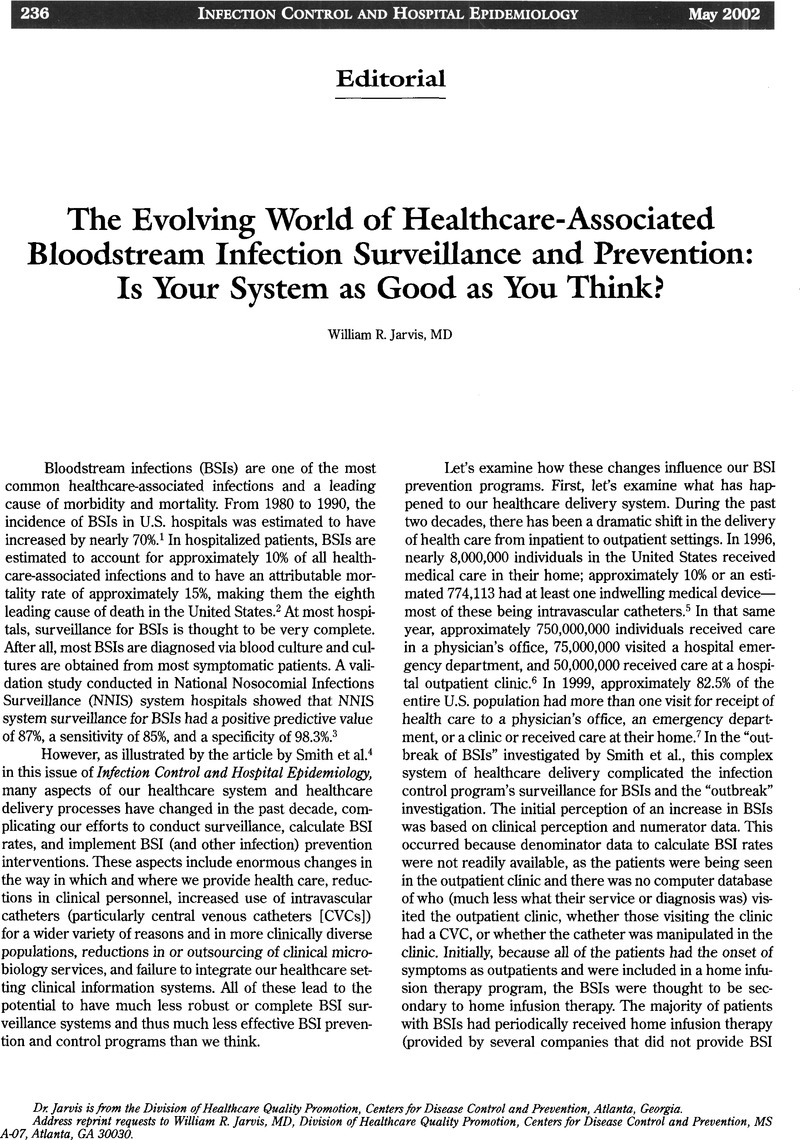Crossref Citations
This article has been cited by the following publications. This list is generated based on data provided by Crossref.
Murphy, Cathryn
and
Resnik, Sue
2006.
A new imperative for the Australian infection control community: improving detection of device-related outbreaks.
Australian Infection Control,
Vol. 11,
Issue. 2,
p.
46.
FRANZETTI, F.
BORGHI, B.
RAIMONDI, F.
and
ROSENTHAL, V. D.
2009.
Impact on rates and time to first central vascular-associated bloodstream infection when switching from open to closed intravenous infusion containers in a hospital setting.
Epidemiology and Infection,
Vol. 137,
Issue. 7,
p.
1041.
2010.
Anforderungen an die Hygiene bei der medizinischen Versorgung von immunsupprimierten Patienten.
Bundesgesundheitsblatt - Gesundheitsforschung - Gesundheitsschutz,
Vol. 53,
Issue. 4,
p.
357.
Rangel-Frausto, Manuel S
Higuera-Ramirez, Francisco
Martinez-Soto, Jose
and
Rosenthal, Victor D
2010.
Should we use closed or open infusion containers for prevention of bloodstream infections?.
Annals of Clinical Microbiology and Antimicrobials,
Vol. 9,
Issue. 1,
Wiersma, Petra
Schillie, Sarah
Keyserling, Harry
Watson, J. Renee
De, Anindya
Banerjee, Shailendra N.
Drenzek, Cherie L.
Arnold, Kathryn E.
Shivers, Christina
Kendrick, Lea
Ryan, Lydia Gonzalez
Jensen, Bette
Noble-Wang, Judith
and
Srinivasan, Arjun
2010.
Catheter-Related Polymicrobial Bloodstream Infections among Pediatric Bone Marrow Transplant Outpatients—Atlanta, Georgia, 2007.
Infection Control & Hospital Epidemiology,
Vol. 31,
Issue. 05,
p.
522.
Uchino, Motoi
Ikeuchi, Hiroki
Matsuoka, Hiroki
Bando, Toshihiro
Ichiki, Kaoru
Nakajima, Kazuhiko
Takahashi, Yoshiko
Tomita, Naohiro
and
Takesue, Yoshio
2014.
Catheter-associated bloodstream infection after bowel surgery in patients with inflammatory bowel disease.
Surgery Today,
Vol. 44,
Issue. 4,
p.
677.
Elmira, Gheytanchi Mashini
and
Romina, Karimzadeh Ghassab
2015.
Assessing the Frequency and Antibiotic Susceptibility Pattern of Isolated Bacteria from Septicemic Hemodialysis Patients.
Focus on Sciences,
Vol. 1,
Issue. 1,
p.
2.
Khan, Mohammad Riaz
Azam, Sadiq
Ahmad, Sajjad
Ali, Qaisar
Liaqat, Zainab
Rehman, Noor
Khan, Ibrar
Alharbi, Metab
and
Alshammari, Abdulrahman
2023.
Molecular Characterization and Epidemiology of Antibiotic Resistance Genes of β-Lactamase Producing Bacterial Pathogens Causing Septicemia from Tertiary Care Hospitals.
Antibiotics,
Vol. 12,
Issue. 3,
p.
617.





